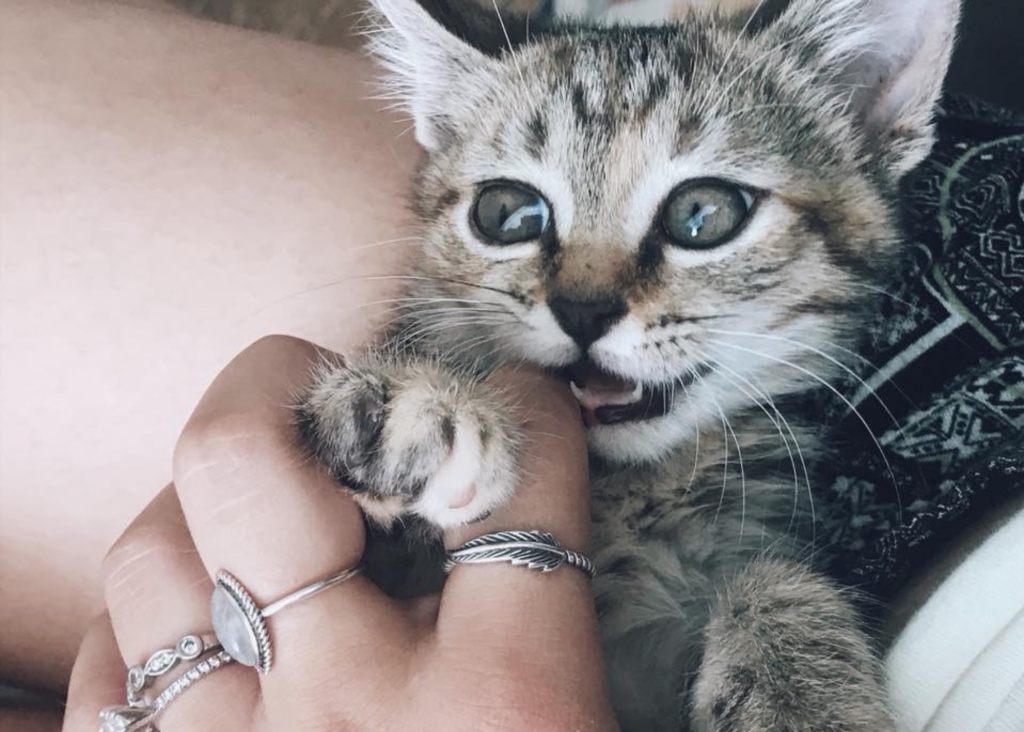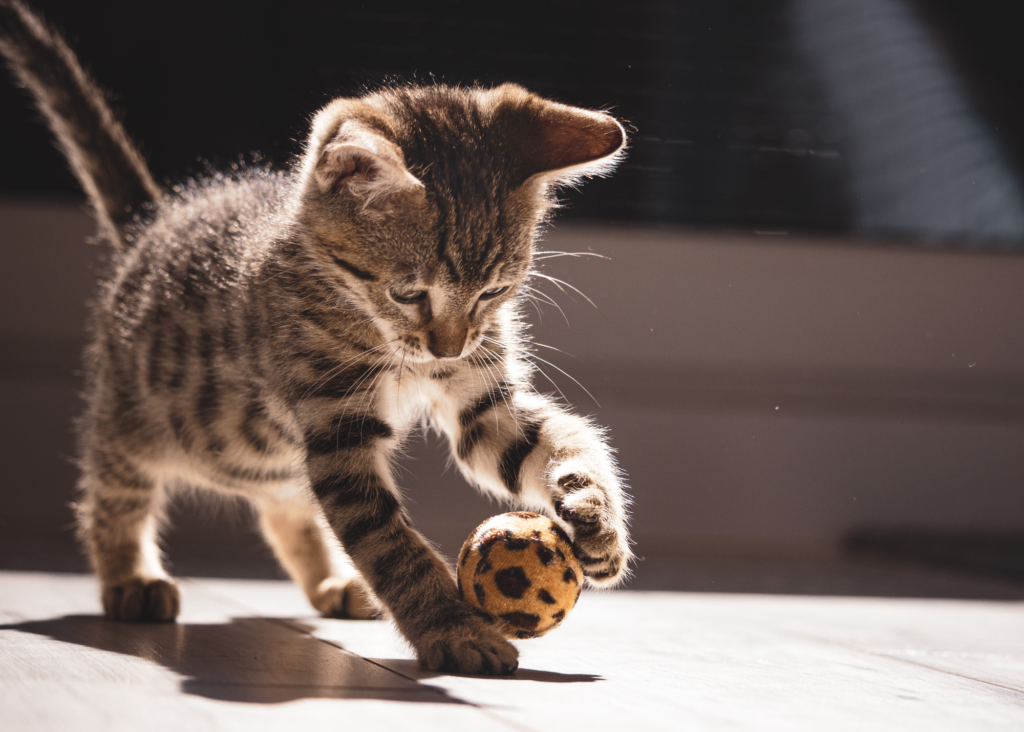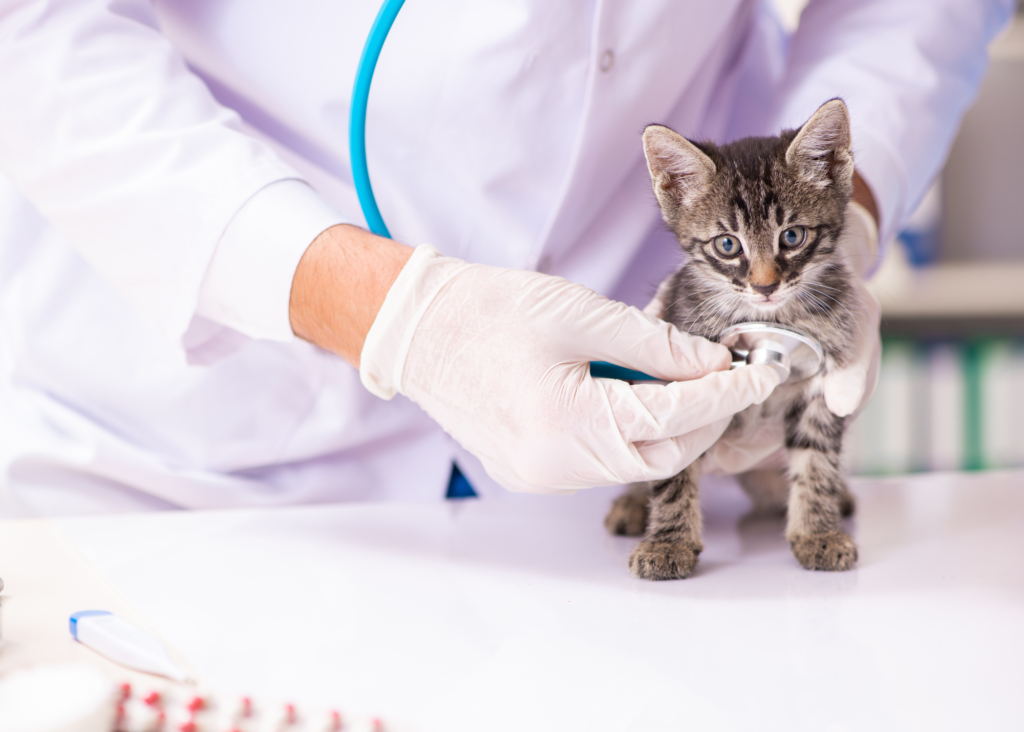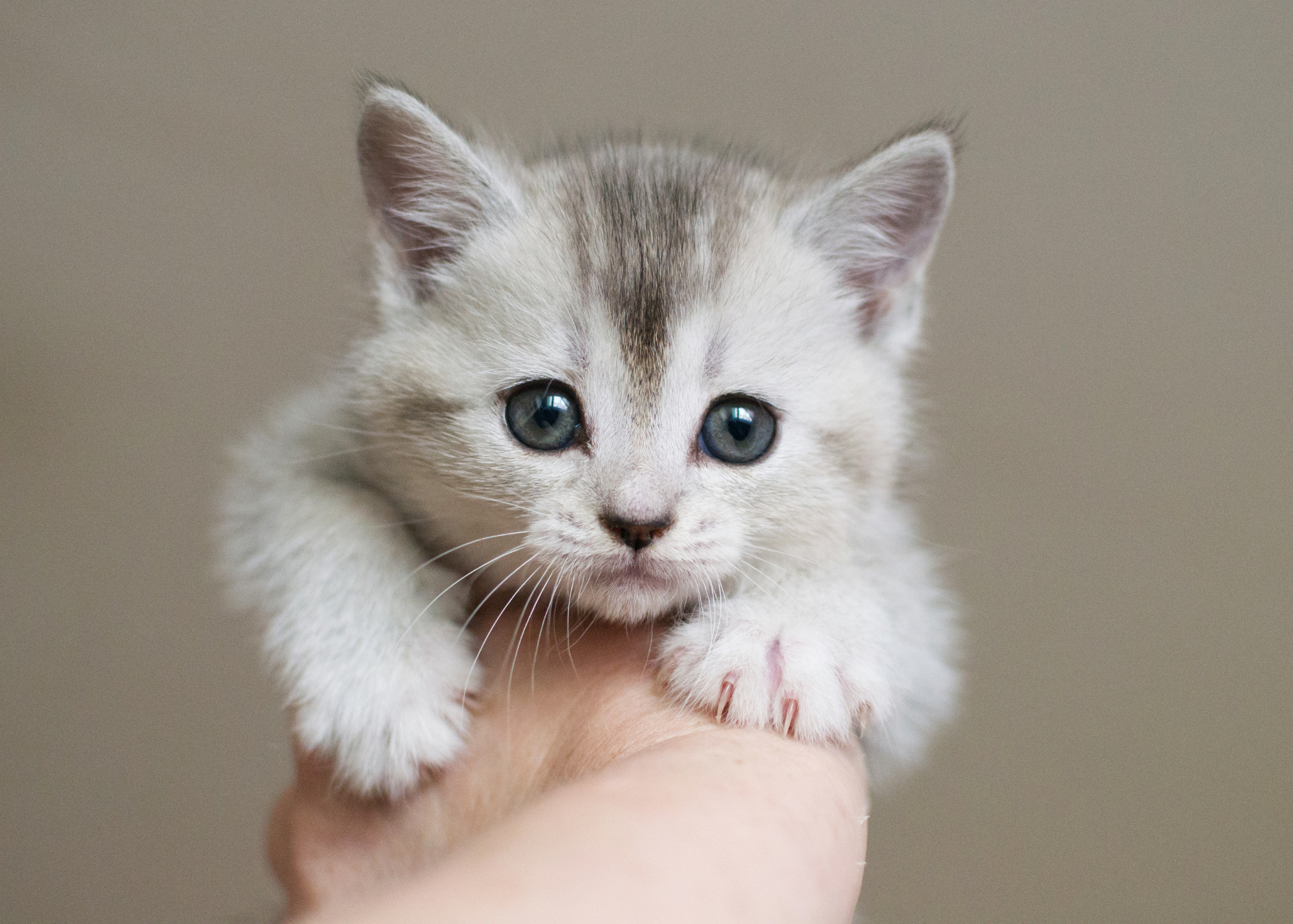How to Socialize a Kitten
Congratulations on your new kitten! You’ve brought them to their new home and are eagerly wondering what your next steps are. While you may be excited to jump right into clicker training, socializing your kitten should be the main focus.
Kitten socialization is vital if your kitten grows into a well-adjusted, social, and confident cat who is comfortable with different situations and environments. Read on for more information on how to socialize a kitten.
Disclosure: Cat School may receive commissions from affiliate links included in this article.
What is Kitten Socialization?
Kitten socialization involves:
- introducing your kitten to other living beings like people and animals
- exposing them to different sights and sounds so they feel safe in the world around them
- getting them comfortable being handled so they accept procedures like nail trims and teeth brushing
- helping them to make positive associations with the world around them so they have the best chance of growing up to be happy and confident
A well-socialized kitten will be more accepting of new people and environments, but also of things like car rides, vet visits, carriers, nail trims, grooming, etc.
It’s important to note that exposing your cat to new things is different from socialization. For example, if you introduce your cat to dogs, but their experiences always consist of the dog chasing or harassing them, your kitten will grow scared or intolerant of dogs rather than accepting them.
Exposing kittens to triggers that cause them to have a fearful response or panic is called “flooding” and will only make your kitten even more scared of you and the situation. Flooding is the same as throwing someone in a pool to teach them to swim.
The key to socialization is to expose your kitten to the new person or environment in a way that’s not scary, PLUS pair good things (treats and toys) with the experience to make it positive.
When Should I Start Socializing My Kitten?
Early socialization with kittens is the key to preventing the fearfulness of humans. It is highly recommended for kittens between 0-12 weeks of age to be exposed to people at least once a week. For example, having your kitten meet friends and family when they are young is worthwhile.
If you’ve adopted a kitten that missed this early socialization period, it’s still possible to socialize them; however, it may take a bit longer to show them that each situation and person is safe. No matter your kitten’s age, socialization is possible and should be a focus when bringing them home.

How to Socialize a Kitten in 13 Ways
As mentioned, socializing kittens means introducing your cat to a possible trigger at a low level so it’s not scary, and then pairing that introduction with something positive – like the food they love. In this list are many ways to begin the kitten socialization process:
1. Pair Food With Touch
We want to build a foundation of trust and cooperation with our kittens, which begins with showing that touch is a positive experience. Instead of giving your kitten all their food in a bowl, you can use their food to strengthen your bond. One of the easiest ways to create this association is by having your cat lick wet food off a spoon while you touch them.
Be sure to touch your kitten’s paws, head, ears, tail and mouth. You can even try opening your kitten’s mouth to inspect their teeth (a great way to lead into teeth brushing!). Not only will your veterinarian thank you for this later, but you’ll also be more familiar with your kitten’s body and able to notice any potential health issues down the road. Practice daily until your kitten is comfortable with touch in all zones, especially the more sensitive ones like their paws.
2. Introduce Grooming Tools
Brushes and nail clippers will be a part of your kitten’s reality, so you want to introduce them early to show that they aren’t scary. Bring out the tools and pair them with your kitten’s favorite treats. When offering your kitten a toothbrush, add something tasty to it and let your kitten lick it.
Tip: Use a more exciting reward for the scarier tools like nail trimmers. The goal is for your kitten to see these tools and get excited.
3. Engage in Play Together
Playing with your kitten will do wonders for their socialization skills and build their confidence. Interactive play is a great bonding activity and a way to build trust.
Throwing a toy out for them to play with on their own isn’t enough. As Dr. Mikel Delgado says, “Toys that are left lying on the floor are ‘dead.’ They are boring.”
Some engaging play ideas include dragging toys under a towel to mimic hunting, alternating the speed and movement of the toy, and using toys with different sounds (think rustling and crushing sounds). Wand toys are great for this.

4. Use Food Puzzle/Foraging Toys
Food puzzle toys are beneficial for many reasons. They provide physical and mental enrichment, help reduce boredom and stress, and allow your kitten to act on their natural hunting/foraging instincts.
There are many different foraging toys, such as snuffle mats, stationary puzzle toys, mobile puzzle toys, etc. Let your kitten try out different ones, so they get as much experience and opportunity to put their foraging skills to the test as possible. You will also be able to figure out their learning style and foraging preferences.
5. Have Visitors to Your Home
For your kitten to be comfortable around new people (besides you and members of your household), you should introduce them to outside people regularly. These “outsiders” can be friends, family members, neighbors, whoever!
As with everything related to kitten socialization, your kitten needs to make positive associations with these visitors. Have the visitors pet your kitty, give them treats, play with them, and talk to them sweetly. Only allow people to hold your kitten if it’s something your kitten enjoys; being forcibly held will not help your kitten learn that people are good.
Fear Free recommends having your kitten meet someone new every day for the first 14 weeks of their life. The more you can work on this skill, the better.
6. Start Carrier Training
Car rides with your cat are inevitable, and you will need to take your kitten to the vet at some point, at the very least. And who knows – you may eventually move, need to take your cat on a road trip, or even start adventuring with your cat.
If your cat is riding in the car, they should be riding in an enclosed carrier for safety reasons. Carrier training adult cats can sometimes be tricky, so it’s best to start the process when your kitten is young.
Leave the carrier out, feed your kitten in it, and put catnip and toys inside it to make it a fun and enticing place. We want your kitten to associate the carrier with positive things, making being in the carrier and future car rides much easier!
7. Go on Car Rides
Speaking of car rides, they are something that you should practice regularly. Once your kitten is comfortable in their carrier, you can start, introducing them to the car. Gradually work your way up from just sitting in the car in the driveway to short rides around the block to longer rides around town.
As with everything, the goal is to make car rides a positive experience for your kitten! If you have a partner, they can be responsible for putting treats inside the carrier throughout the journey. Visit Starbucks, get yourself a snack for your efforts (training is hard work), and give your kitten some treats for coming along for the ride. Introducing your kitten to car rides will make traveling with them so much easier.
8. Make Happy Visits to the Vet
It’s no secret that vet visits can be stressful and scary for cats, but it doesn’t have to be that way. You can set up “happy visits” to the vet to counteract the negativity. A happy visit is when you take your kitten to the vet exclusively for pets and treats. You can let the vet techs and your veterinarian handle and love your kitten to make the experience positive, reducing their fear and stress the next time they have to go for an actual wellness visit.
If you’re able to find a Fear Free certified veterinarian, that’s even better, since they will be especially focused on making your kitten’s vet visits stress-free.

9. Introduce Your Kitten to Cat-Friendly Dogs
Socializing a young kitten includes socializing with other animals in addition to humans. You may decide to get a dog in the future, so you want your cat to have some exposure to them. Even if you have a resident dog who shares the home with your kitten, you should still practice meeting other dogs. Your kitty is bound to run into strange dogs at some point, whether in the lobby at your vet’s office or while you’re out on a leash walk.
As mentioned earlier, the key is ensuring these dog interactions are positive. If you have friends or family members who have “cat-friendly” dogs, start there, and ask them to come to your home and bring their dog.
Set up safe and controlled interactions (have the dog on a leash or behind a gate so the dog never chases the cat. You want to start by letting your kitten observe the dog up high, where they are safe. Use treats so your kitten associates the dogs with positive things.
10. Try Out Different Foods and Treats
Cats are notoriously picky eaters, so introduce your cat to different foods and treats when they’re young to expand their palette. Allow them to try various protein sources, textures, and flavors. Cats learn to be picky by only giving them one food, so we want to avoid this by encouraging them to accept a variety of meals and snacks.
Hint: Make a mental note of their favorite things so you can use them for training sessions later!
11. Introduce Your Cat to Different Sounds
One of the scariest things for unsocialized kittens is loud noises – sirens, fireworks, construction, dogs barking, etc. While these sounds may be complex for you to practice with “in real life,” recordings of sounds from Youtube can be an excellent first step to desensitizing them.
You can also open your windows (as long as they have screens) or give your cat access to a catio or outside playpen so they can experience these sounds in a controlled environment. Car rides will also help introduce your cat to the sounds of the outside world.
12. Experience Different Textures
This may seem silly, but walking on different surfaces and textures can be startling for some cats. As with the different food and sounds, you should introduce your cat to the feel of different textures such as carpet, hardwood, concrete, and grass. Have your cat follow wet food on a spoon over many surfaces. Cats can be startled by changes in their environment. For example, even moving a rug around can be startling. Reward your kitten for treating new surfaces like a fun obstacle course.
13. Begin Harness & Leash Training
Harness and leash training should be a part of every cat’s training process. Even if you don’t have grand plans to travel and adventure with your cat, there are other situations in which harness and leash training can come in handy. For example, in an emergency, visiting the vet, moving, etc.
Being harness and leash-trained will allow you and your kitten to enjoy some safe outdoor time together. Because we don’t recommend letting your cat free-roam outdoors, harness and leash training your kitten is the best way to let your cat experience the outdoor world in a safe and controlled manner.
While older cats can be harness trained, introducing your kitten to the harness and leash when they are young can speed up the process.
When Can You Start the Socialization Process?
Your socialization training can begin as soon as you bring your kitten home. Though it’s never too early or too late to begin, starting with socialization at an early age is best. However, the socialization window never fully closes – you can still work with an older kitten.
If you’re lucky, you may even have Kitten Kindergarten classes near you. In kitten kindergarten, you would get help from a trainer and/or cat behaviorist with all of the above-mentioned socialization steps. These classes are becoming more and more popular for good reason, and hopefully the future will see more opportunities to make it easier to socialize kittens.
In addition to the socialization skills mentioned in this article, you can also start clicker training your kitten. Clicker training helps to teach your kitten self-control and to focus on you. When you’re ready, you can begin incorporating clicker training basics into your routine. Parking spot training is especially helpful.
Remember to have fun as you work on all these skills with your cat – socialization and training are about enriching your kitten’s life, setting them up for success and happiness, and building that bond and sense of trust between the two of you. It should be a positive experience for you both.
If you come across anything you need help with or would like to dive deeper into your cat’s training, be sure to join the Cat School Membership group. In Cat School, you have direct access to cat behaviorist Julie Posluns, and you’ll be able to follow her training roadmap with video tutorials and step-by-step lessons. Her goal is to help you give your cat the best life possible!
Sources:
Pratsch, L., Mohr, N., Palme, R., Rost, J., Troxler, J., & Arhant, C. (2018). Carrier training cats reduces stress on transport to a veterinary practice. Applied Animal Behaviour Science, 206, 64–74. doi:10.1016/j.applanim.2018.05.025
Dantas, L. M., Delgado, M. M., Johnson, I., & Buffington, C. T. (2016). Food puzzles for cats. Journal of Feline Medicine and Surgery, 18(9), 723–732. doi:10.1177/1098612×16643753

